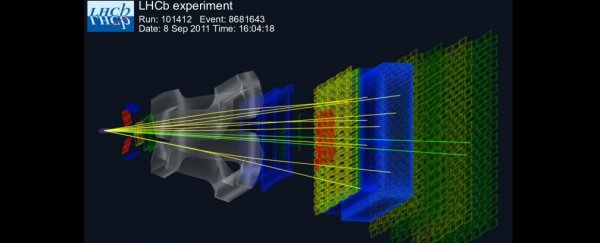Researchers at the Large Hadron Collider (LHC) at CERN in Switzerland have found evidence of subatomic particles acting in a way that defies the Standard Model of particle physics - the current best set of equations we have to explain the behaviour and interactions of particles in the Universe.
This Standard Model has served us pretty well so far, but there are some significant holes, the most glaring being the fact that it doesn't account for gravity. So for decades physicists have been trying to find physics occurring beyond the Standard Model, using machines such as the LHC to help them find clues. And now they may finally have a huge lead.
An international team of physicists has found hints of leptons - a specific type of subatomic particle - behaving in strange ways not predicted by the Standard Model. They uncovered this while looking at the decay of particles called B mesons into lighter particles, including two types of leptons: the tau lepton and the muon.
According to a key Standard Model concept called 'lepton universality', all leptons are treated equally by all fundamental forces, which means that all leptons should decay at the same rate, once corrected for any difference in mass. But in the data, the team found a small but notable difference in the predicted rates of decay. This suggests that some type of as-yet undiscovered forces or particles could be interfering.
"The Standard Model says the world interacts with all leptons in the same way. There is a democracy there. But there is no guarantee that this will hold true if we discover new particles or new forces," one of the lead researchers, Hassan Jawahery, from the University of Maryland in the US, said in a press release. "Lepton universality is truly enshrined in the Standard Model. If this universality is broken, we can say that we've found evidence for non-standard physics."
It would be tempting to disregard this finding as an anomaly, if it wasn't for the fact that a similar discovery about lepton decay was made by the BaBar experiment at the Stanford Linear Accelerator Centre in the US in 2012. This experiment also looked at the decay of B mesons, but it achieved this decay by smashing together electrons, rather than the protons that power the LHC.
"The experiments were done in totally different environments, but they reflect the same physical model. This replication provides an important independent check on the observations," University of Maryland physicist Brian Hamilton explained. "The added weight of two experiments is the key here. This suggests that it's not just an instrumental effect - it's pointing to real physics."
The team now needs to confirm their observations with further experiments. The data used for this research were collected during the first run of the LHC between 2011 and 2012 - the same run that found the Higgs boson, which was the last missing piece of the Standard Model. But now that the particle accelerator is on its second run and achieving record-breaking energy levels, they'll have an even better chance of catching the decay in action again.
"We are planning a range of other measurements. The LHCb experiment is taking more data during the second run right now," said Jawahery. "Any knowledge from here on helps us learn more about how the universe evolved to this point. For example, we know that dark matter and dark energy exist, but we don't yet know what they are or how to explain them. Our result could be a part of that puzzle … If we can demonstrate that there are missing particles and interactions beyond the Standard Model, it could help complete the picture."
The results will be published in the September 4 issue of Physical Review Letters, but have been published on arXiv ahead of time. We can't wait to see what researchers at the LHC find next.
